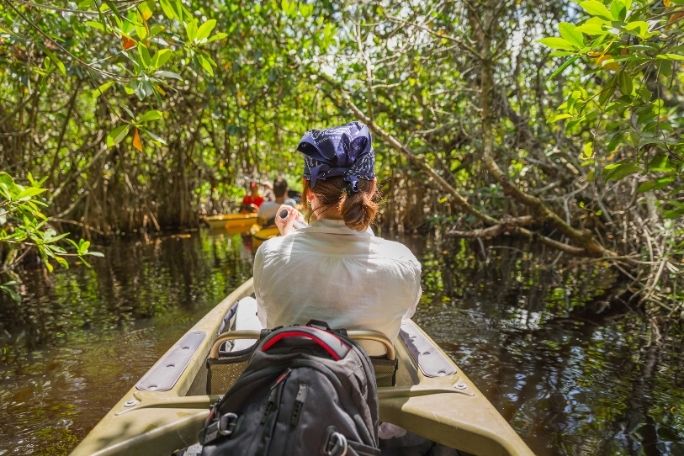Lesson summary
Students communicate their MangroveWatch findings based on primary and secondary evidence. Their interpretation of data and critical evaluation of the evidence-gathering process is used to formulate conclusions and suggestions for ecological actions to conserve mangroves and salt marshes. Students work through a scaffold for creating a scientific report for a specific purpose to complete this sixth and final lesson.
Learning intentions:
Students will...
- understand how to create a scientific report to communicate their understanding of the causes and effects of variables influencing the ecological stability and conservation of mangroves and salt marsh.
Success criteria:
Students can...
- use a visual aid in the form of a cause and effect diagram to analyse threatening processes to the ecological stability of mangrove ecosystems
- describe adaptations of mangrove and salt marsh species
- make informed predictions about the influence of coastal squeeze
- applies knowledge to suggest conservation management and/or further research
- presents a logical, and accurate scientific report
- effective use of digital, visual, written and oral communication.
Lesson guides and printables
Curriculum links
Select your curriculum from the options below.
Lesson details
Curriculum mapping
Australian curriculum content descriptions:
Year 9 Science:
- Ecosystems consist of communities of interdependent organisms and abiotic components of the environment; matter and energy flow through these systems (ACSSU176)
- Critically analyse the validity of information in primary and secondary sources and evaluate the approaches used to solve problems (ACSIS172)
- Communicate scientific ideas and information for a particular purpose, including constructing evidence-based arguments and using appropriate scientific language, conventions and representations (ACSIS174)
Year 10 Science:
- Global systems, including the carbon cycle, rely on interactions involving the biosphere, lithosphere, hydrosphere and atmosphere (ACSSU189)
- Critically analyse the validity of information in primary and secondary sources and evaluate the approaches used to solve problems (ACSIS206)
- Communicate scientific ideas and information for a particular purpose, including constructing evidence-based arguments and using appropriate scientific language, conventions and representations (ACSIS208)
Year 11 and 12 Science – Biology
- Represent data in meaningful and useful ways; organise and analyse data to identify trends, patterns and relationships; qualitatively describe sources of measurement error, and uncertainty and limitations in data; and select, synthesise and use evidence to make and justify conclusions (ACSBL004)
- Select, construct and use appropriate representations, including classification keys, food webs and biomass pyramids, to communicate conceptual understanding, solve problems and make predictions (ACSBL006)
- Communicate to specific audiences and for specific purposes using appropriate language, nomenclature, genres and modes, including scientific reports (ACSBL007)
Syllabus outcomes: SC5-14LW, SC5-7WS, SC5-8WS, SC5-9WS, SC5-12ES
General capabilities: Critical and Creative Thinking, Literacy
Cross-curriculum priority: Sustainability OI.7
Relevant parts of Year 9 Science achievement standards: Students analyse how biological systems function and respond to external changes with reference to interdependencies, energy transfers and flows of matter. They analyse trends in data, identify relationships between variables and reveal inconsistencies in results. They analyse their methods and the quality of their data, and explain specific actions to improve the quality of their evidence. They evaluate methods and explanations from a scientific perspective and use appropriate language and representations when communicating their findings and ideas to specific audiences.
Relevant parts of Year 10 Science achievement standards: Students describe and analyse interactions and cycles within and between Earth’s spheres. When analysing data, selecting evidence and developing and justifying conclusions, they identify alternative explanations for findings and explain any sources of uncertainty. They construct evidence-based arguments and select appropriate representations and text types to communicate science ideas for specific purposes.
Year 11 and 12 Science students:
- use science inquiry skills to design, conduct, evaluate and communicate investigations into biodiversity and flows of matter and energy in a range of ecosystems.
Unit of work: MangroveWatch – Years 9 to 12
Time required: 180 minutes
Level of teacher scaffolding: Medium – the worksheets are scaffolded to guide students. This approach frees the teacher to support students through the problem solving process and the communication of a scientific report.
Resources required
- Student Worksheet – one copy per student
- Internet access
- Natural Selection Factsheet
- Report Writing Guide
- Resources students need to present and create a scientific report for a specific purpose and audience
- Scientific Report Assessment Rubric
- Whiteboard, butcher’s paper or interactive whiteboard
Skills
This lesson is designed to build students’ competencies in the following skills:
- Creativity
- Critical thinking
Additional info
The lessons in this unit have been developed in partnership with Earthwatch and MangroveWatch. Earthwatch is a global not-for-profit organisation that uses citizen science to empower people to save the natural world, and works with all sectors to create a society that lives in balance with nature. MangroveWatch is a not-for-profit organisation that focuses on the research, education and conservation of mangrove and tidal wetland environments globally.


Welcome back!
Don't have an account yet?
Log in with:
Create your free Cool.org account.
Many of our resources are free, with an option to upgrade to Cool+ for premium content.
Already have an account?
Sign up with:
By signing up you accept Cool.org's Terms and Conditions(Opens in new tab) and Privacy Policy(Opens in new tab).